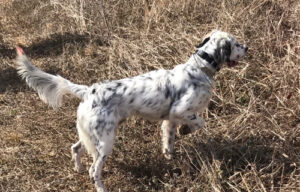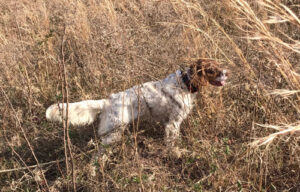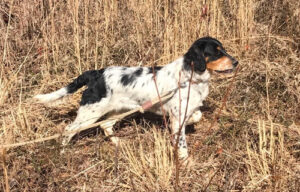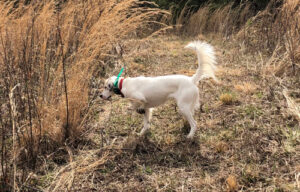Kennels
When you visit our kennels, you’ll quickly notice that all of our dogs are Setters. Most people think they are English Setters, which is not technically wrong, but we would say they are better than English Setters, they are Llewellin Setters!
Meet Our Llewellin Setters
We don’t select or breed our dogs to meet the AKC Standard for English Setters, because we’re not interested in show dogs. We select and breed dogs to be excellent Upland Game hunters. So far we have not been disappointed. Let us introduce you to our dogs.
 Merle
Merle
Whelped 12-12-2016
Merle is a high-energy tri-colored belton Llewellin Setter who will hunt all day long. He won’t give up on finding a bird, even in the thickest of cover. Merle is extremely intelligent and wants to please. He will hunt a little wide when you want him to. Merle won 1st Place in the Gun Dog Division of the Alabama Quail Hunter’s Harold Ridgeway Memorial Field Trial on March 6, 2021 at Brierfield Farm.
 Dottie
Dottie
Whelped 4-19-2018
Dottie is a chestnut and white ticked Llewellin Setter with an excellent pedigree which includes lineage from Highway Dan and Henry Prince of Pause. She has a mild temperament, but when you drop the tail gate, she’s all business! She is a meticulous hunter with a natural instinct to circle running birds and close them in.
 Retta
Retta
Whelped 7-17-2018
Retta is a tri-colored patch/ticked Llewellin Setter. She is smaller in size than our other dogs, but she’s a mighty hunter. Retta’s pedigree has championship bloodlines, and she has excellent field instincts. She has been remarkably easy to train. We have entered her in 3 field trials, and she has placed in every one. On November 9, 2019, Retta won 1st Place in the Derby Division of the Alabama Quail Hunter’s Fall Field Trial. She was not yet 14 months old. On March 7, 2020, she won 2nd Place in the Derby Division of the Alabama Quail Hunter’s Spring Field Trial, and on March 6, 2021 she placed 3rd in the Derby Division of the Spring Field Trial.
 Daisy
Daisy
Whelped 11-3-2018
Daisy is mostly white with mild black ticking. She has good field instincts with an excellent nose. She is high-energy and as fast as greased lightning. She will hunt a little wide when you want her to. We are frequently amazed at Daisy’s ability to smell a bird from a great distance.
 Chet
Chet
Whelped 4-20-2020
Chet is the baby of our bunch. He’s a black and white patch/ticked Llewellin Setter. He has a mild temperament and descended from Alderbrook grouse hunting stock. He is very affectionate with a desire to please.
The Story of the Llewellin Setter
Aren’t they the same as English Setters? Well, the story starts back in approximately 1825 when Edward Lavarack, an Englishman, began breeding Setters for field qualities and their beauty in an effort to turn English Setters into a pure breed. He began with two dogs, Ponto and Old Moll, which he closely inbred to develop what we know as the English Setter.
Mr. Laverack was very interested in defining and describing the English Setter breed. While it was never his intent to do so, his book, The Setter, published in 1872 was considered to be the definitive book on the breed and became the basis for what is now the English Setter Standard for show type English Setters.
During the 1860’s, R. Purcell Llewellin, a Welshman from Pembrokeshire, South Wales, began a breeding program with dogs that he purchased from Edward Lavarack with a focus on developing dogs for fieldwork. In 1871, while attending a field trial in Shewbury, Llewellin purchased two dogs, Dan and Dick, to breed with this Lavarack females. Both of the dogs were sired by a dog named Duke, belonging to Barclay Field and a Dam named Rhoebe, owned by Thomas Statter. It’s interesting to note that Rhoebe’s Dam was half South Esk, a now extinct breed, and half Gordon. Both Duke and Rhoebe were from Northern England and had a reputation for outstanding field work.
The pairing of the Lavarack Dogs with the offspring of Duke and Rhoebe was the genesis of the Llewellin Setter. Purcell Llewellin’s breeding program focused on outcrossed breeding to intensify traits he wanted like superior scenting ability or natural tendency to point birds, even if they were a different breed. His pairings produced offspring that were exactly what he was looking for, and quickly attracted the attention of bird hunters in England and North America.
Purcell Llewellin’s dog, Dan, sired Gladstone, who became recognized as a top field performer and sire, and a new era of bird dogs began. What is now known as the Llewellin Setter was born as a breed with excellence in hunting and field trials. Gladstone was exported to Canada, and later to the United States. His field performance and achievements significantly impacted the growing popularity of Llewellins. Count Gladstone IV won the very first National Bird Dog Championship in 1896.
Today we have the English Setter AKC standard derived from Mr. Laverack’s vision and definition of the correct breed type. We also have the Llewellin Setter based on Mr. Llewellin’s breeding program. A Llewellin Setter is a pure strain of the English Setter with bloodlines that can be traced back to R. Purcell Llewellin’s breeding of the Duke-Rhoebe-Laverack bloodlines. Today the Field Dog Stud Book (FDSB) of Chicago, published by American Field, registers Llewellin Setters as those English Setters whose lineage traces back to the R. Purcell Llewellin breeding program. The American Kennel Club considers Llewellin Setter as just another name for English Setter.
Llewellin Setter Traits
Llewellin Setters typically weigh between 35 to 60 lbs (a little smaller than most English Setters). Llewellins also have less feathering on the tail, legs, and belly than an English Setter. They are very active dogs and need a significant amount of exercise every day. Once they’ve had their playtime, they are content to settle in for the remainder of the day.
Llewellins are great hunters, and an excellent choice for the walking hunter. They are bred to hunt, and excel at hunting quail, pheasant or grouse. They are intelligent, have a keen sense of smell, a natural ability to point, and have a tendency to stay close to the gun on a hunt. They will often circle back to check on hunters and don’t generally run off. Keep in mind that while Llewellin Setters are bred to hunt, they don’t just know how to hunt. They still require training, but you will find that most Llewellin Setters are easy to train and have a desire to please their hunters.
If you’re considering purchasing a Llewellin Setter, there is lots of information available on the various bloodlines of Llewellin Setters. We are not going to expand on all those here, but it can feel a bit overwhelming as you’re learning about the breed. Some of the bloodlines include Dashing Bonhu, Windem, Gladstone and Blizzard. That’s not an exhaustive list, just a beginning to help you understand the Bloodline language. Check out our Links Page for other sites to learn more about the breed.
Markings and Color
When choosing a puppy, many of the most frequently asked questions evolve around the colors of Llewellin Setters. It’s fun to watch Llewellin Setters develop their colors. The colors lemon and chestnut where often culled in the early days of Setter breeding because they were considered to be inferior. Consequently those colors tend to be more rare simply because fewer dogs were bred with those colors dominant. Let’s look at a brief description of markings and color.
Colors – White, Black, Blue, Lemon, Orange, Chestnut; when we refer to blue, it refers to white with black ticking that makes the coat appear to have a blue hue. On occasions we’ve heard people refer to a Llewellin as “Liver” colored. The AKC English Setter standard refers to Liver colored Setters, but not Chestnut. Here at Blackburn Fork Preserve, we consider dogs with a deep red brown color to be Chestnut. For example, our Dottie is Chestnut. We would consider a liver color to be more dark brown with less red, closer to Chocolate, but in most cases with Llewellin Setter fans, “Liver” and “Chestnut” are used interchangeably.
Ticking – White with colored specs are referred to as “ticking.” A mostly white dog with very little ticking is referred to as “lightly ticked.” A coat so heavily ticked that it looks colored with flecks of white, is referred to as “roan.” Roan can refer to any color of ticking. The AKC Standard for English Setters prefers all over ticking for show dogs.
Patches – large solid patches of color on or around the eye, head, ears, or on the body. The AKC Standard for English Setter allows for patches on the head or ears, but patches on the body are considered undesirable for show dogs.
Belton – Belton is the name of the village where Edward Laverack liked to hunt. In the Setter color-scheme, it refers to a dog with ticking but no patches. A true belton will have no colored patches, even on the ears. A true belton will be born all white. For all purists, this is true. However, you will often hear people refer to a ticked dog with patches on the ears or eyes as belton.
Blue Belton – white with black ticking
Lemon Belton – white with orange ticking, pink pigment on the nose, light colored eyes. The AKC Standard for English Setters, which was derived from Edward Laverack’s book, values only dark eyes. As a matter of fact the standard says the darker the better.
Chestnut/Liver Belton – white with chestnut/liver ticking
Orange Belton – white with orange or tan ticking, dark pigment on the nose
Tri-Color – When two colors combine with white, it’s called tri-colored. For example, white with black and orange ticking, which may be referred to as a blue/orange tri. It’s also possible to have a chestnut/orange tri or a lemon/orange tri.

